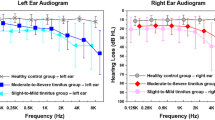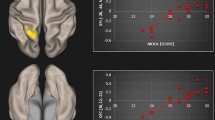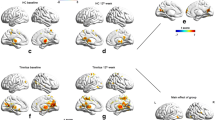Abstract
Tinnitus is an ongoing phantom percept. It has been demonstrated that bifrontal transcranial direct current stimulation (tDCS) can reduce tinnitus. In this study, one group of patients reported a substantial improvement in their tinnitus perception, whereas another group described minor or no beneficial effect at all. The objective was to verify whether the activity and connectivity of the resting brain is different for people who will respond to bifrontal tDCS for tinnitus in comparison with non-responders. Higher gamma band activity was demonstrated in right primary and secondary auditory cortex and right parahippocampus for responders. It has been shown that gamma band activity in the auditory cortex is correlated with tinnitus loudness and that the anterior cingulate is involved in tinnitus distress. People who were going to respond to bifrontal tDCS also demonstrated an increased functional connectivity in the gamma band between the right dorsolateral prefrontal cortex (DLPFC) and the right parahippocampus as well as the right DLPFC and subgenual anterior cingulate cortex (sgACC). An analysis revealed that responders to bifrontal tDCS also experienced a larger suppression effect on TMS placed over the right temporal cortex (i.e. auditory cortex) than non-responders. Responders to bifrontal tDCS seem to differ in resting brain activity compared to non-responders in the right auditory cortex and parahippocampal area. They also have a different functional connectivity between DLPFC and, respectively, the sgACC and parahippocampal area. These connectivities might explain the suppression effect for both tinnitus loudness and tinnitus-related distress.



Similar content being viewed by others
References
Alain C, Woods DL, Knight RT (1998) A distributed cortical network for auditory sensory memory in humans. Brain Res 812:23–37
Antal A, Kincses TZ, Nitsche MA, Bartfai O, Paulus W (2004a) Excitability changes induced in the human primary visual cortex by transcranial direct current stimulation: direct electrophysiological evidence. Invest Ophthalmol Vis Sci 45:702–707
Antal A, Varga ET, Kincses TZ, Nitsche MA, Paulus W (2004b) Oscillatory brain activity and transcranial direct current stimulation in humans. Neuroreport 15:1307–1310
Axelsson A, Ringdahl A (1989) Tinnitus–a study of its prevalence and characteristics. Br J Audiol 23:53–62
Beeli G, Casutt G, Baumgartner T, Jancke L (2008) Modulating presence and impulsiveness by external stimulation of the brain. Behav Brain Funct 4:33
Blood AJ, Zatorre RJ, Bermudez P, Evans AC (1999) Emotional responses to pleasant and unpleasant music correlate with activity in paralimbic brain regions. Nat Neurosci 2:382–387
Bodner M, Kroger J, Fuster JM (1996) Auditory memory cells in dorsolateral prefrontal cortex. Neuroreport 7:1905–1908
Boggio PS, Zaghi S, Lopes M, Fregni F (2008) Modulatory effects of anodal transcranial direct current stimulation on perception and pain thresholds in healthy volunteers. Eur J Neurol 15:1124–1130
Boggio PS, Zaghi S, Fregni F (2009) Modulation of emotions associated with images of human pain using anodal transcranial direct current stimulation (tDCS). Neuropsychologia 47:212–217
Boutros NN, Trautner P, Rosburg T, Korzyukov O, Grunwald T, Schaller C, Elger CE, Kurthen M (2005) Sensory gating in the human hippocampal and rhinal regions. Clin Neurophysiol 116:1967–1974
Boutros NN, Mears R, Pflieger ME, Moxon KA, Ludowig E, Rosburg T (2008) Sensory gating in the human hippocampal and rhinal regions: regional differences. Hippocampus 18:310–316
Congedo M (2002) EureKa! (Version 3.0) [Computer Software]. Knoxville, TN: NovaTech EEG Inc. Freeware available at http://www.NovaTechEEG
De Ridder D, De Mulder G, Walsh V, Muggleton N, Sunaert S, Moller A (2004) Magnetic and electrical stimulation of the auditory cortex for intractable tinnitus. Case report. J Neurosurg 100:560–564
De Ridder D, Verstraeten E, Van der Kelen K, De Mulder G, Sunaert S, Verlooy J, Van de Heyning P, Moller A (2005) Transcranial magnetic stimulation for tinnitus: influence of tinnitus duration on stimulation parameter choice and maximal tinnitus suppression. Otol Neurotol 26:616–619
De Ridder D, Fransen H, Francois O, Sunaert S, Kovacs S, Van De Heyning P (2006) Amygdalohippocampal involvement in tinnitus and auditory memory. Acta Otolaryngol Suppl 12:50–53
De Ridder D, De Mulder G, Verstraeten E, Seidman M, Elisevich K, Sunaert S, Kovacs S, Van der Kelen K, Van de Heyning P, Moller A (2007a) Auditory cortex stimulation for tinnitus. Acta Neurochir Suppl 97:451–462
De Ridder D, van der Loo E, Van der Kelen K, Menovsky T, van de Heyning P, Moller A (2007b) Theta, alpha and beta burst transcranial magnetic stimulation: brain modulation in tinnitus. Int J Med Sci 4:237–241
De Ridder D, Vanneste S, van der Loo E, Plazier M, Menovsky T, van de Heyning P (2010) Burst stimulation of the auditory cortex: a new form of neurostimulation for noise-like tinnitus suppression. J Neurosurg 112:1289–1294
Eggermont JJ, Roberts LE (2004) The neuroscience of tinnitus. Trends Neurosci 27:676–682
Fregni F, Boggio PS, Nitsche MA, Marcolin MA, Rigonatti SP, Pascual-Leone A (2006a) Treatment of major depression with transcranial direct current stimulation. Bipolar Disord 8:203–204
Fregni F, Boggio PS, Nitsche MA, Rigonatti SP, Pascual-Leone A (2006b) Cognitive effects of repeated sessions of transcranial direct current stimulation in patients with depression. Depress Anxiety 23:482–484
Fuchs M, Kastner J, Wagner M, Hawes S, Ebersole JS (2002) A standardized boundary element method volume conductor model. Clin Neurophysiol 113:702–712
Grunwald T, Boutros NN, Pezer N, von Oertzen J, Fernandez G, Schaller C, Elger CE (2003) Neuronal substrates of sensory gating within the human brain. Biol Psychiatry 53:511–519
Heller AJ (2003) Classification and epidemiology of tinnitus. Otolaryngol Clin North Am 36:239–248
Jurcak V, Tsuzuki D, Dan I (2007) 10/20, 10/10, and 10/5 systems revisited: their validity as relative head-surface-based positioning systems. Neuroimage 34:1600–1611
Kahn I, Andrews-Hanna JR, Vincent JL, Snyder AZ, Buckner RL (2008) Distinct cortical anatomy linked to subregions of the medial temporal lobe revealed by intrinsic functional connectivity. J Neurophysiol 100:129–139
Kaltenbach JA (2000) Neurophysiologic mechanisms of tinnitus. J Am Acad Audiol 11:125–137
Kleinjung T, Eichhammer P, Landgrebe M, Sand P, Hajak G, Steffens T, Strutz J, Langguth B (2008) Combined temporal and prefrontal transcranial magnetic stimulation for tinnitus treatment: a pilot study. Otolaryngol Head Neck Surg 138:497–501
Knight RT, Scabini D, Woods DL (1989) Prefrontal cortex gating of auditory transmission in humans. Brain Res 504:338–342
Korzyukov O, Pflieger ME, Wagner M, Bowyer SM, Rosburg T, Sundaresan K, Elger CE, Boutros NN (2007) Generators of the intracranial P50 response in auditory sensory gating. Neuroimage 35:814–826
Landgrebe M, Langguth B, Rosengarth K, Braun S, Koch A, Kleinjung T, May A, de Ridder D, Hajak G (2009) Structural brain changes in tinnitus: grey matter decrease in auditory and non-auditory brain areas. Neuroimage 46:213–218
Langguth B, Eichhammer P, Wiegand R, Marienhegen J, Maenner P, Jacob P, Hajak G (2003) Neuronavigated rTMS in a patient with chronic tinnitus. Effects of 4 weeks treatment. Neuroreport 14:977–980
Langguth B, Hajak G, Kleinjung T, Pridmore S, Sand P, Eichhammer P (2006a) Repetitive transcranial magnetic stimulation and chronic tinnitus. Acta Otolaryngol Suppl 12:102–105
Langguth B, Zowe M, Landgrebe M, Sand P, Kleinjung T, Binder H, Hajak G, Eichhammer P (2006b) Transcranial magnetic stimulation for the treatment of tinnitus: a new coil positioning method and first results. Brain Topogr 18:241–247
Lewis JW, Beauchamp MS, DeYoe EA (2000) A comparison of visual and auditory motion processing in human cerebral cortex. Cereb Cortex 10:873–888
Llinas RR, Ribary U, Jeanmonod D, Kronberg E, Mitra PP (1999) Thalamocortical dysrhythmia: a neurological and neuropsychiatric syndrome characterized by magnetoencephalography. Proc Natl Acad Sci USA 96:15222–15227
Londero A, Langguth B, De Ridder D, Bonfils P, Lefaucheur JP (2006) Repetitive transcranial magnetic stimulation (rTMS): a new therapeutic approach in subjective tinnitus? Neurophysiol Clin 36:145–155
Margulies DS, Kelly AM, Uddin LQ, Biswal BB, Castellanos FX, Milham MP (2007) Mapping the functional connectivity of anterior cingulate cortex. Neuroimage 37:579–588
Masten CL, Eisenberger NI, Borofsky LA, Pfeifer JH, McNealy K, Mazziotta JC, Dapretto M (2009) Neural correlates of social exclusion during adolescence: understanding the distress of peer rejection. Soc Cogn Affect Neurosci 4:143–157
Meeus O, Blaivie C, Ost J, De Ridder D, Van de Heyning P (2009) Influence of tonic and burst transcranial magnetic stimulation characteristics on acute inhibition of subjective tinnitus. Otol Neurotol 30:697–703
Miranda PC, Lomarev M, Hallett M (2006) Modeling the current distribution during transcranial direct current stimulation. Clin Neurophysiol 117:1623–1629
Mirz F, Pedersen B, Ishizu K, Johannsen P, Ovesen T, Stodkilde-Jorgensen H, Gjedde A (1999) Positron emission tomography of cortical centers of tinnitus. Hear Res 134:133–144
Mirz F, Gjedde A, Ishizu K, Pedersen CB (2000) Cortical networks subserving the perception of tinnitus–a PET study. Acta Otolaryngol Suppl 543:241–243
Mitchell TV, Morey RA, Inan S, Belger A (2005) Functional magnetic resonance imaging measure of automatic and controlled auditory processing. Neuroreport 16:457–461
Muhlau M, Rauschecker JP, Oestreicher E, Gaser C, Rottinger M, Wohlschlager AM, Simon F, Etgen T, Conrad B, Sander D (2006) Structural brain changes in tinnitus. Cereb Cortex 16:1283–1288
Muhlnickel W, Elbert T, Taub E, Flor H (1998) Reorganization of auditory cortex in tinnitus. Proc Natl Acad Sci USA 95:10340–10343
Nichols TE, Holmes AP (2002) Nonparametric permutation tests for functional neuroimaging: a primer with examples. Hum Brain Mapp 15:1–25
Nitsche MA, Paulus W (2000) Excitability changes induced in the human motor cortex by weak transcranial direct current stimulation. J Physiol 527 Pt 3: 633–639
Nitsche MA, Paulus W (2001) Sustained excitability elevations induced by transcranial DC motor cortex stimulation in humans. Neurology 57:1899–1901
Nitsche MA, Nitsche MS, Klein CC, Tergau F, Rothwell JC, Paulus W (2003) Level of action of cathodal DC polarisation induced inhibition of the human motor cortex. Clin Neurophysiol 114:600–604
Norena A, Cransac H, Chery-Croze S (1999) Towards an objectification by classification of tinnitus. Clin Neurophysiol 110:666–675
Pascual-Marqui RD (2002) Standardized low-resolution brain electromagnetic tomography (sLORETA): technical details. Methods Find Exp Clin Pharmacol 24 (Suppl D): 5–12
Pascual-Marqui R (2007a) Discrete, 3D distributed, linear imaging methods of electric neuronal activity. Part 1: exact, zero error localization. http://arxiv.org/abs/0710.3341
Pascual-Marqui R (2007b) Instantaneous and lagged measurements of linear and nonlinear dependence between groups of multivariate time series: frequency decomposition. http://arxiv.org/abs/0711.1455
Plewnia C, Reimold M, Najib A, Reischl G, Plontke SK, Gerloff C (2007) Moderate therapeutic efficacy of positron emission tomography-navigated repetitive transcranial magnetic stimulation for chronic tinnitus: a randomised, controlled pilot study. J Neurol Neurosurg Psychiatr 78:152–156
Pridmore S, Fernandes Filho JA, Nahas Z, Liberatos C, George MS (1998) Motor threshold in transcranial magnetic stimulation: a comparison of a neurophysiological method and a visualization of movement method. J ECT 14:25–27
Rauschecker JP, Leaver AM, Muhlau M (2010) Tuning out the noise: limbic-auditory interactions in tinnitus. Neuron 66:819–826
Rossi S, Ferro M, Cincotta M, Ulivelli M, Bartalini S, Miniussi C, Giovannelli F, Passero S (2007) A real electro-magnetic placebo (REMP) device for sham transcranial magnetic stimulation (TMS). Clin Neurophysiol 118:709–716
Schlee W, Hartmann T, Langguth B, Weisz N (2009) Abnormal resting-state cortical coupling in chronic tinnitus. BMC Neurosci 10:11
Schneider P, Andermann M, Wengenroth M, Goebel R, Flor H, Rupp A, Diesch E (2009) Reduced volume of Heschl’s gyrus in tinnitus. Neuroimage 45:927–939
Smits M, Kovacs S, de Ridder D, Peeters RR, van Hecke P, Sunaert S (2007) Lateralization of functional magnetic resonance imaging (fMRI) activation in the auditory pathway of patients with lateralized tinnitus. Neuroradiology 49:669–679
Tulving E, Markowitsch HJ (1997) Memory beyond the hippocampus. Curr Opin Neurobiol 7:209–216
van der Loo E, Gais S, Congedo M, Vanneste S, Plazier M, Menovsky T, Van de Heyning P, De Ridder D (2009) Tinnitus intensity dependent gamma oscillations of the contralateral auditory cortex. PLoS ONE 4: e7396: 7391–7395
Vanneste S, Plazier M, der Loo E, de Heyning PV, Congedo M, De Ridder D (2010a) The neural correlates of tinnitus-related distress. Neuroimage 52:470–480
Vanneste S, Plazier M, Ost J, van der Loo E, Van de Heyning P, De Ridder D (2010b) Bilateral dorsolateral prefrontal cortex modulation for tinnitus by transcranial direct current stimulation: a preliminary clinical study. Exp Brain Res 202:779–785
Voisin J, Bidet-Caulet A, Bertrand O, Fonlupt P (2006) Listening in silence activates auditory areas: a functional magnetic resonance imaging study. J Neurosci 26:273–278
Weisz N, Dohrmann K, Elbert T (2007a) The relevance of spontaneous activity for the coding of the tinnitus sensation. Prog Brain Res 166:61–70
Weisz N, Muller S, Schlee W, Dohrmann K, Hartmann T, Elbert T (2007b) The neural code of auditory phantom perception. J Neurosci 27:1479–1484
Zald DH, Pardo JV (2002) The neural correlates of aversive auditory stimulation. Neuroimage 16:746–753
Conflict of interest
None.
Author information
Authors and Affiliations
Corresponding author
Additional information
Funded by Tinnitus Network initiative.
Rights and permissions
About this article
Cite this article
Vanneste, S., Focquaert, F., Van de Heyning, P. et al. Different resting state brain activity and functional connectivity in patients who respond and not respond to bifrontal tDCS for tinnitus suppression. Exp Brain Res 210, 217–227 (2011). https://doi.org/10.1007/s00221-011-2617-z
Received:
Accepted:
Published:
Issue Date:
DOI: https://doi.org/10.1007/s00221-011-2617-z




